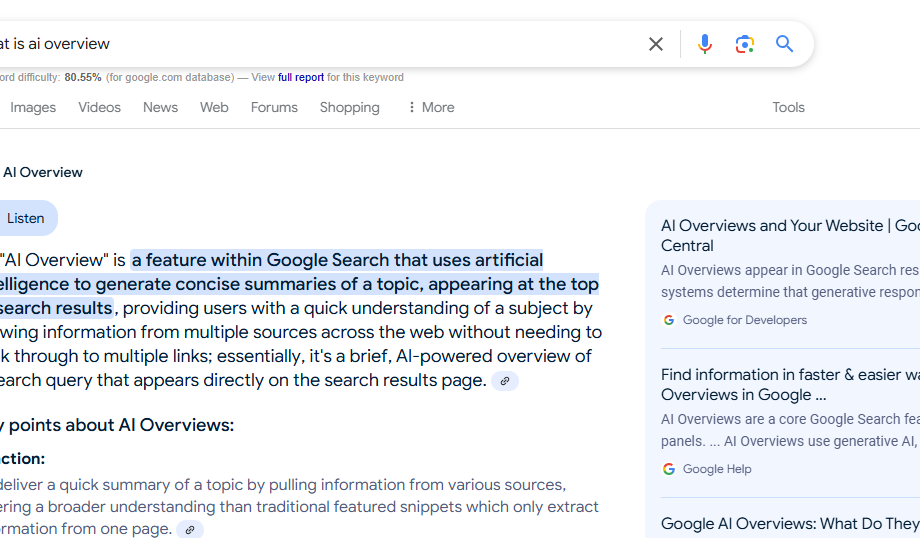In today’s fast-evolving digital landscape, artificial intelligence (AI) is no longer a futuristic concept—it’s here and transforming how we interact with technology. One of the most significant areas where AI makes waves is in search engine optimization (SEO). With tools like Google AI in search, AI-generated search results, and AI-powered content optimization, how websites rank and perform is changing rapidly. In this blog, we’ll dive into what AI overviews are, how they work, and their impact on SEO.
Introduction:
AI overviews are AI-driven summaries or insights generated by search engines to provide users with quick, accurate, and relevant answers to their queries. These overviews are powered by advanced machine-learning algorithms that analyze vast amounts of data to deliver precise results. For example, when you search for “best Italian restaurants near me,” Google might display an AI-generated snippet featuring top-rated restaurants, their ratings, and even user reviews—without clicking on a single link.
This shift is part of Google’s broader effort to enhance user experience by leveraging AI in search. But what does this mean for SEO? Let’s explore.
What Are AI Overviews?
AI overviews are essentially dynamic, context-aware summaries that appear at the top of search engine results pages (SERPs). They are designed to save users time by immediately answering their questions.
For example:
If you search for “how to bake a chocolate cake,” Google might display an AI-generated step-by-step guide right on the SERP, complete with ingredients and instructions.
For a query like “What is climate change,” you might see a concise definition, key facts, and figures.
These overviews are powered by natural language processing (NLP) and machine learning, enabling search engines to understand user intent and deliver highly relevant content.
How Do AI Overviews Work?
AI overviews rely on advanced algorithms that analyze user queries, context, and existing content to generate accurate summaries. Here’s a simplified breakdown of the process:
1. Query Analysis: The AI system first interprets the user’s search query, identifying its intent. For example, is the user looking for information, a product, or a service?
2. Data Aggregation: The system then scans its database, pulling information from trusted sources, websites, and other relevant content.
3. Content Synthesis: Using NLP, the AI condenses the information into a concise, easy-to-read format.
4. Display: The final overview is displayed at the top of the SERP, often as a featured snippet, knowledge panel, or carousel.
This process is seamless and happens in milliseconds, thanks to the power of AI in search.
How to Optimize for AI Overviews
With AI overviews becoming more prevalent, website owners and marketers must adapt their SEO strategies. Here are some tips to optimize your content for AI-generated search results:
1. Focus on User Intent:
Create content that directly addresses user queries. Use tools like Google’s “People Also Ask” section to identify common questions about your niche.
2. Structure Your Content:
Use clear headings, bullet points, and short paragraphs to make your content easy to scan. AI systems prefer well-organized content.
3. Leverage Semantic Keywords:
Incorporate related terms and phrases that align with your primary keywords. For example, if your keyword is “AI-powered content optimization,” include terms like “machine learning in SEO” or “automated content tools.”
4. Optimize for Featured Snippets:
Aim to provide concise, authoritative answers to common questions. Use schema markup to help search engines understand your content better.
5. Enhance E-A-T (Expertise, Authoritativeness, Trustworthiness):
AI systems prioritize content from credible sources. Build your website’s authority through backlinks, user reviews, and high-quality content.
The GEO Impact on Organic Searches
AI overviews are changing how content is displayed and influencing local SEO and geo-targeted searches. For example, if a user searches for “coffee shops in New York,” Google’s AI might display a list of popular cafes along with their locations, ratings, and photos.
This means businesses need to:
Optimize their Google My Business profiles.
Use location-specific keywords.
Ensure their NAP (Name, Address, Phone Number) information is consistent across all platforms.
Doing so increases your chances of appearing in AI-generated local search results.
FAQs About AI Overviews
1. Will AI overviews reduce website traffic?
While AI overviews provide quick answers, they don’t necessarily reduce traffic. They can drive qualified traffic by attracting genuinely interested users to your content. By optimizing for featured snippets and providing in-depth information, you can encourage users to click through to your website.
2. How can small businesses compete with AI overviews?
Small businesses can compete by focusing on niche-specific content and local SEO. By addressing unique queries and optimizing for local searches, you can carve out a space for yourself in AI-generated results.
Conclusion
AI overviews are reshaping the SEO landscape, offering both business challenges and opportunities. You can stay ahead of the curve by understanding how Google AI in search works and optimizing your content for AI-generated search results. Remember, the key to success is creating high-quality, user-focused content that aligns with the evolving capabilities of AI-powered content optimization.
Embrace the change, adapt your strategies, and watch your website thrive in the age of AI-driven search with SEO Expert USA.
 :
https://www.pinterest.com/seoxpertusa/
:
https://www.pinterest.com/seoxpertusa/












